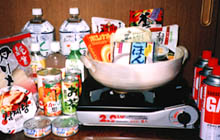 |
 |
 |
 |
 |
 |
|||||
 |
 |
 |
 |
| WHAT MILLENNIUM BUG? Computer Glitch Caused Few Problems February 23, 2000  Stoves and survival food sold well in the run-up to Y2K. As the year 2000 began Japan, like many nations around the world, braced itself for computer malfunctions caused by the Y2K bug. So far there have been no problems impacting directly on the economy, society, or daily life. The efforts made by the public and private sectors to counter the problem seem to have been successful. There are still, however, some dates, such as February 29, that need careful attention, and the government and other concerned institutions plan to remain vigilant. The Cost of Keeping Y2K at Bay Even in Japan, as 2000 approached there were growing fears that essential services, such as electricity, communications, and transport, would stop, that there would be food and water shortages, or that nuclear power plants would run out of control. The central government, other public authorities, and related institutions, as well as the private sector, made huge efforts and spent large sums on measures to combat the problem, such as computer inspections and software reconfiguration. It was in this context that toward the end of 1999 Prime Minister Keizo Obuchi issued a public safety announcement, stating that the government anticipated "no serious impact on everyday life as a result of damage to the social infrastructure and consequent loss of services." He pointed out, however, that, "It is important for everyone in the country to be prepared in the event that problems do arise," and called on people to at least prepare a supply of food, water, and medicines as a minimum precaution. This contributed to a rush by many citizens to buy extra stocks of food that keeps well, triggering a burst of "millennium spending." According to the major supermarket chains, sales of products for coping with the Y2K problem shot up from the beginning of December. Sales of drinking water, portable cooking stoves, and fuel for these stoves were two and a half to three times higher than for the same period the previous year, sales of batteries were one and a half times higher, while sales of oil heaters and canned food rose by more than 30%. More Problem Dates to Come The private sector also took steps to combat Y2K. Railway companies, such as East Japan Railway Co., stopped all their trains at the nearest station for several minutes either side of midnight to check for problems. Other providers of such essential services as electricity, gas, transportation, telecommunication, finance, and health care, as well as companies in the computer, electrical equipment, auto, and distribution industries took the step of keeping employees on duty or on standby through the night. It is estimated that the total number of public- and private-sector employees mobilized this way exceeded 2 million. Japan greeted the new year without any Y2K-related difficulties, and the Y2K center at the Prime Minister's Official Residence shut up shop on January 5. Chief Cabinet Secretary Mikio Aoki summed up: "We have been able to pass without serious incident the year end and New Year period, which was watched carefully. This is a result of measures for the Y2K issue by both the private and public sectors, and I would like to express my sincere respect for the efforts of all those concerned." There were, however, a few problems. According to information collected by the government before January 5, there were 47 reported incidents in five key areas of the private sector, of which 27 were attributed to the Y2K glitch. These included a malfunctioning data transmission system at a nuclear power station, monitors displaying an incorrect date at a meteorological facility, and irregularities in mail sent by mobile phone. These were minor incidents but are still causing problems. There are also concerns that more problem days lie ahead. Some computers may not be programmed to accommodate the practice of making only century years divisible by 400 leap years. Malfunctions may occur on February 29, consequently, with another day being the changeover to fiscal 2000 on April 1. Both the public and private sectors need to remain vigilant.  Edited by Japan Echo Inc. based on domestic Japanese news sources. Articles presented here are offered for reference purposes and do not necessarily represent the policy or views of the Japanese Government. Edited by Japan Echo Inc. based on domestic Japanese news sources. Articles presented here are offered for reference purposes and do not necessarily represent the policy or views of the Japanese Government.
|

